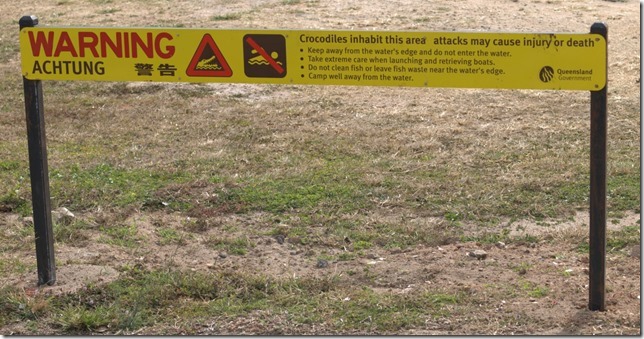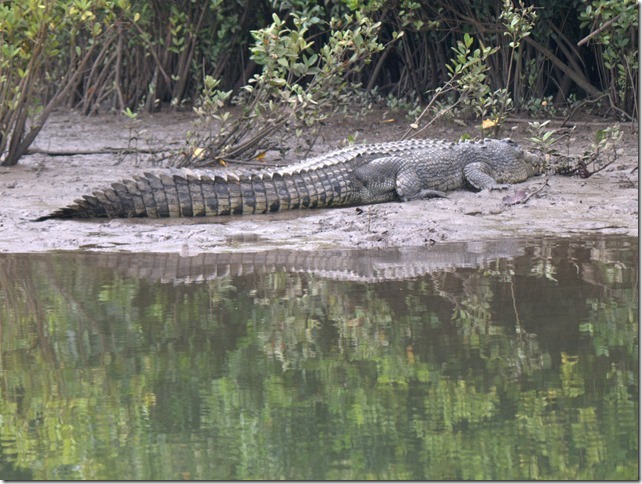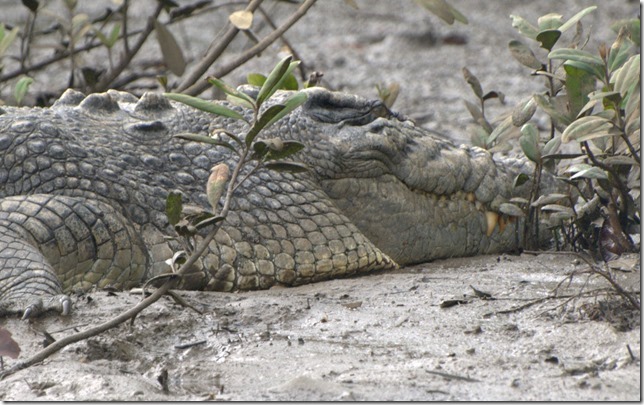Be careful when swimming

VulcanSpirit
Richard & Alison Brunstrom
Mon 1 Sep 2014 13:16
|
The crew of Vulcan Spirit has just returned from a two week land safari of
Tropical North Queensland (TNQ), an activity which included swimming. In TNQ
this requires care, knowledge and risk management. There are three principal
risks – jellyfish, sharks and crocs.
Jellyfish are seasonal and this is not the season thankfully (they are
tiny, invisible and can be fatal; if not fatal the pain can be excruciating). A
full body stocking and hood provides good protection but facial stings can be
awful. Bottles of vinegar are provided at all beaches – these can be a
lifesaver. But it’s not their season, so no worries.
Sharks kill fewer people in Australia each year than do cattle. Great
Whites, the most dangerous, do not live in the Tropics, though other dangerous
species do. Sharks feed mostly at night, so swimming when the sun is high in the
sky is considered fairly safe. The risk of shark attack in TNQ, though not zero,
is pretty low. But not no worries.
Crocs are a different matter. There are two crocodiles in
Australia – the supposedly harmless-to-humans Johnstone’s Freshwater Crocodile
Crocodylus johnstoni which does not live in this part of
Queensland (so no worries there), and the Estuarine Crocodile Crocodylus
porosus, which does and which is most definitely not harmless to humans.
This is an animal worth worrying about – there have been four fatal attacks in
the adjacent state, Northern Territory, so far this year. Estuarine crocodiles,
salties, are very common. They are the world’s largest reptile (a big male can
reach 7m and perhaps more and weigh 2 tonnes), they are at home in saltwater or
fresh and have been found 1000nm out to sea and hundreds of kilometres inland.
They can live for a year without eating if trapped in an isolated waterhole
during the dry season, they can run faster than a human over short distances and
can take prey as large as a full grown cow weighing over a tonne. These are not
animals to be messed with. Females are smaller and stop growing at about 4m.
They are fiercely territorial and will guard about 1km of river. Males never
stop growing; they cruise around looking for mates (this is the mating season),
so they travel along the coast and up the rivers. Like sharks they feed mostly
at night, and you really do not want to get too close to one. No water, salt or
fresh, is truly safe here, especially at night. They prefer muddy estuarine
water, so swimming the river at night while drunk (a common cause of death) is a
really bad idea. So is cleaning fish guts on a boat ramp. Last week’s casualty
was fishing on a river bank. His $10 lure got caught, he waded in to retrieve it
up to his knees and was taken, in front of his wife on the bank. Official advice
is not to camp within 50m horizontally or 2m vertically of any river. Every
piece of water, salt or fresh, has one of these signs at every access
point:
 This one is at the entrance to the tourist caravan park at Cooktown. One
side is the town, the other a mangrove swamp. Makes for tense camping.
The VS crew undertook a croc spotting tour which is big business in TNQ
(crocs are now fully protected and are nearly back to pre-European population
levels). Metal boats are required because the crocs can’t eat them. Here is a
female croc sunning herself on a river bank (this is winter so cooler; they’re
cold blooded so need the sun’s warmth – in the summer they stay in the water all
the time):
 Interestingly this one is only about 50m upriver from the sandy beach upon
which unsuspecting tourist are playing.
And here is a male, a biggish one at about 5-6m:
 He had just arrived in the river the previous day, having travelled the
length of a tourist beach in order to get there. He is clearly very well fed,
and has lovely big teeth:
 Here you can see his armour. The ridges are not just lumps, they are solid
bone embedded in skin. It is almost like chain mail, and makes them incredibly
tough, almost impervious to attack by other animals:
 These are fearsome predators, and certainly added a frissance when swimming
in the sea. Freshwater swimming is a complete no-no unless you are upstream of a
big waterfall, or completely bonkers.
On land in TNQ you only really have to worry about snakes. A lot.
|